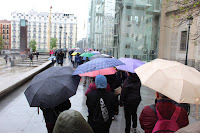[Infelizmente várias zonas de Madrid estão em confinamento, como a Usera e Puente de Vallecas (não sei quase nada dos bairros administrativos de Madrid, estou-me a basear num mapa do jornal ABC). Este passeio passa-se em regiões bastante próximas, Arcazuela, Enbajadores e Atocha, mais concretamente na Rua dos Embajadores, no Museu Rainha Sofia e na Estação de Atocha]
Até às duas primeiras décadas do século XX só teremos higiene, assépsia e sais de mercúrio para combater as infecções. Depois, partindo da ideia da “bala mágica” de Erlich, teremos o salvarsan, medicamento orgânico de arsénio, eficaz contra a sífilis, mas embora com efeitos menos graves que o mercúrio, continuará a ter muitos efeitos sencundários. Com Domek, quando a Bayer se juntou à BASF, entre outras e formaram a I.G. Farben, surgiram as sulfamidas que impediam as bactérias de produzir ácido fólico. São só estas que estão disponíveis para as infecções antes de 1943 e podem ser fabricadas nas fábricas de medicamentos militares.
Mais ao lado fica o Museu da Rainha Sofia. Quando o visitámos, chovia e havia grandes filas. Uma ocasião para ver discretamente os pigmentos e os materiais (essencialmente poliéster) dos guarda-chuvas. Há vários outros aspectos, claro, mas em termos químicos são mais interessantes os processos, os materiais e as moléculas. São de notar as peças feitas de zinco, vidro, acrílico e outros materiais. Há um xadrez de cobre e magnésio de Carl André. Os pigmentos merecem também a nossa atenção. Curiosamente havia um letreiro na casa de banho a explicar como se lavavam as mãos (estranha premonição de 2019). E havia uma exposição sobre as viagens marítimas mas realçando os seus aspectos mais estranhos e menos conhecidos e os materiais envolvidos.
Daí fomos visitar e relaxar nos jardins tropicais da estação de combóios de Atocha. Muitas plantas foram cultivadas pelos materiais e produtos químicos que davam. Desde logo a celulose que está na origem do algodão e do papel, e de todas as suas modificações, tanto como polímeros como fibras (o celofane, o lyocel, o rayon e a viscose, por exemplo) e as modificações químicas que originaram os explosivos nitrocelulose e o celulóide. E também pelos produtos para que podem ter contribído, o acúcar, o café, o tabaco, o cacau, a borracha, entre outros.
[Translation, semi-authomatic, corrected]
Virtual chemical trails in Madrid in times of confinement
[Unfortunately, several areas of Madrid are in strict confinement, such as Usera and Puente de Vallecas (I know almost nothing about the administrative districts of Madrid, I am based on a map from the ABC newspaper). This trail takes place in regions very close (Arcazuela, Embajadores and Atocha) more specifically at Street of Embajadores, at the Rainha Sofia Museum and at Atocha Station]
On the street of Embajadores is situated the old tobacco factory, now a cultural center, and the old military medicine factory (google tells me). In cities, industries are being expelled due to real estate pressure, foul smells (the old slaughterhouse is nearby and Google also tells tha is cultural center), danger and lack of space. Of course, as you would expect, in Madrid there is a monument and places dedicated to Fleming, but this not what I want to talk about. In the street of Ambassadores it makes sense to mention the antibacterials that existed before penicillin.
Until the first two decades of the twentieth century, we will only have hygiene, asepsis and mercury salts to fight infections. Then, based on the idea of Erlich's “magic bullet”, we will have salvarsan, an organic arsenic medicine, effective against syphilis, but although with less serious effects than mercury, it will continue to have many secondary effects. With Domek, when Bayer joined BASF, among others, to form I.G. Farben, sulfamides appeared. That prevented bacteria from producing folic acid and are the only ones that were available for infections before 1943. This can be manufactured in military medicine factories.
Nearby it is the Queen Sofia Museum. When we visited it, it was raining and there were long lines. This is an occasion to discreetly see the pigments and materials (essentially polyester) of umbrellas. There are several other aspects, of course, but in chemical terms, processes, materials and molecules are interesting. Note the pieces made of zinc, glass, acrylic and other materials. There is a copper and magnesium chess by Carl André, for example. Inks and pigments also deserve our attention. Interestingly, there was a sign in the bathroom explaining how to wash hands (strange premonition of 2019!) And there was an exhibition about the discoveries, but highlighting its strangest and least known aspects, and also the materials involved.
Then, we went to visit and relax in the tropical gardens of the Atocha train station. Many plants were grown for the materials and the chemicals they gave. We can start obviously with cellulose that is the source of cotton and paper, and all its modifications, both as polymers and fibers (cellophane, lyocel, rayon and viscose, for example) and the chemical modifications that originated the explosive nitrocellulose and the polymer celluloid. And also for the products to which they may have contributed, sugar, coffee, tobacco, cocoa, rubber, among others. All natural, all chemical.















Sem comentários:
Enviar um comentário